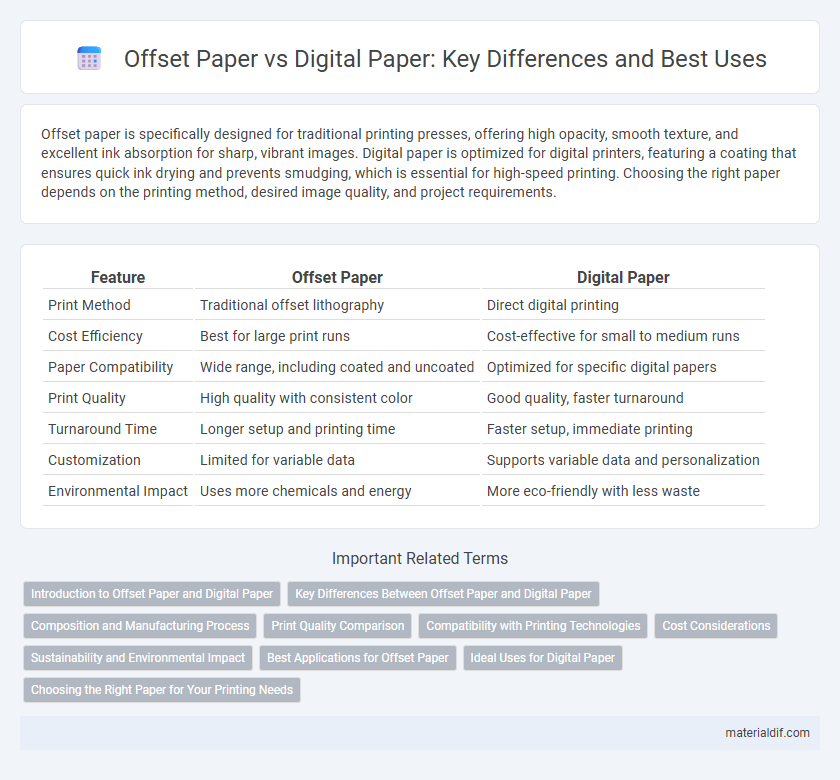Offset paper is specifically designed for traditional printing presses, offering high opacity, smooth texture, and excellent ink absorption for sharp, vibrant images. Digital paper is optimized for digital printers, featuring a coating that ensures quick ink drying and prevents smudging, which is essential for high-speed printing. Choosing the right paper depends on the printing method, desired image quality, and project requirements.
Table of Comparison
| Feature | Offset Paper | Digital Paper |
|---|---|---|
| Print Method | Traditional offset lithography | Direct digital printing |
| Cost Efficiency | Best for large print runs | Cost-effective for small to medium runs |
| Paper Compatibility | Wide range, including coated and uncoated | Optimized for specific digital papers |
| Print Quality | High quality with consistent color | Good quality, faster turnaround |
| Turnaround Time | Longer setup and printing time | Faster setup, immediate printing |
| Customization | Limited for variable data | Supports variable data and personalization |
| Environmental Impact | Uses more chemicals and energy | More eco-friendly with less waste |
Introduction to Offset Paper and Digital Paper
Offset paper, designed for traditional printing processes, features high-opacity and smooth surfaces ideal for offset lithography, ensuring sharp image reproduction and color fidelity. Digital paper, optimized for inkjet or laser printers, typically offers enhanced brightness and consistent texture to support quick drying and precise toner adhesion. Both paper types differ in coating, weight, and finish to meet specific printing technologies and quality standards in publishing and commercial printing industries.
Key Differences Between Offset Paper and Digital Paper
Offset paper is specifically designed for traditional offset printing processes, featuring high opacity, smooth surface, and uniform thickness to ensure sharp image quality and color accuracy. Digital paper, optimized for inkjet and laser printers, typically has a special coating to enhance ink absorption and prevent smudging, resulting in vivid colors and quicker drying times. The main difference lies in their compatibility with printing technologies, as offset paper excels in durability for large print runs, while digital paper offers flexibility and superior print quality for short runs and variable data printing.
Composition and Manufacturing Process
Offset paper is primarily composed of wood pulp and is manufactured through a traditional process involving pulping, bleaching, and pressing to create a dense, smooth surface ideal for offset printing. Digital paper, often made from a blend of wood pulp and synthetic fibers, undergoes a specialized coating process that enhances toner adhesion and color vibrancy for high-resolution digital prints. The distinct manufacturing techniques directly influence the paper's texture, weight, and ink absorption properties, optimizing each type for its specific printing technology.
Print Quality Comparison
Offset paper delivers superior print quality with sharp, vibrant colors and precise detail due to its smooth surface and ink absorption properties, making it ideal for high-volume, professional printing. Digital paper, while improving rapidly, often shows less color consistency and sharpness because of its coating variations and reliance on toner or inkjet technology. For projects demanding fine text and rich imagery, offset paper remains the preferred choice for exceptional print clarity and durability.
Compatibility with Printing Technologies
Offset paper offers superior compatibility with traditional printing technologies such as lithographic presses due to its high ink absorption and smooth surface, ensuring sharp image reproduction. Digital paper is engineered for inkjet and laser printers, featuring coatings that optimize toner adhesion and prevent smudging, which enhances print clarity on demand. Selection between offset and digital paper depends largely on the printing technology used and the desired print quality and durability.
Cost Considerations
Offset paper production involves higher upfront costs due to setup processes like plate making and press calibration, making it more cost-effective for large print runs. Digital paper eliminates these setup expenses, resulting in lower initial costs and greater flexibility for small or customized print jobs. The choice between offset and digital paper largely depends on the print volume and budget allocation, with offset favoring high-volume projects and digital optimizing cost efficiency for shorter runs.
Sustainability and Environmental Impact
Offset paper typically uses trees as a raw material and involves chemical-intensive processing, leading to higher carbon emissions and deforestation concerns. Digital paper, compatible with electronic or printed documents, reduces physical paper consumption, lowering waste and conserving natural resources, but its sustainability depends on the energy sources powering digital devices. Sustainable choices between offset and digital paper require evaluating life cycle impacts, including energy use, emissions, recyclability, and resource depletion.
Best Applications for Offset Paper
Offset paper excels in high-volume printing applications such as magazines, brochures, and newspapers due to its superior color fidelity and cost-efficiency. Its smooth surface and high opacity make it ideal for detailed images and vibrant graphics that require consistent print quality. Offset paper's durability and ability to handle large press runs position it as the best choice for commercial printing projects demanding precision and reliability.
Ideal Uses for Digital Paper
Digital paper excels in environments requiring frequent editing, instant sharing, and eco-friendly practices, such as in digital note-taking, graphic design, and online document collaboration. It supports seamless integration with digital tools, enhancing productivity through features like searchability, cloud storage, and real-time updates. Unlike offset paper, digital paper reduces physical waste and costs, making it ideal for businesses and educational institutions shifting toward paperless workflows.
Choosing the Right Paper for Your Printing Needs
Offset paper offers superior color accuracy and durability, making it ideal for high-volume, professional-quality print jobs such as brochures and magazines. Digital paper is designed for short-run, customizable prints with quick turnaround times, providing excellent performance on inkjet and laser printers. Selecting the right paper depends on print volume, desired finish, and compatibility with your printing technology.
Offset paper vs Digital paper Infographic

 materialdif.com
materialdif.com